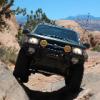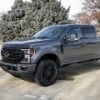
Shortening the body, Lengthen the overhead.
#1

Posted 13 November 2011 - 02:04 AM
Can anyone think of a reason that this can't be done?
#2

Posted 13 November 2011 - 05:03 AM
Off the top of my head the issues you face are:
cantilever strength
COG concerns - most concern probably should someone jump into the bunk while not tied to a truck.
That's about all I can think of.
#3

Posted 13 November 2011 - 06:28 PM
Where does that road go?
#4

Posted 13 November 2011 - 09:52 PM
At some point you'll be better off starting from scratch and not being forced into compromises based on existing compromises. I suspect that such a project is treading on the cusp of this. This is the sort of thing that is hard to see from the front of the project, but is plainly obvious in hindsight. BT, DT on my own projects as well as those for customers.
Hard to say, starting with a current rig gets you a complete roof that is matched to the upper camper outline, including the front radius corners which would take a bit of effort to make at home. I'd take a good look at what the cantilever pieces look like and how long into the main camper they go to evaluate their ability to handle the additional cantilever. Even if you rework a bunch of the lower frame as long as you didn't spend much on the camper you'll probably come out ahead verse starting from scratch.
But it'll be a fairly involved project either way.
Gerdo, I forgot did you mention what kind of welder you have (mig or tig)? Some of the folks that have make modifications/repairs to their FWC frames have said the metal is thin and difficult to work with on a mig setup, just food for thought in case you hadn't read that in your research.
2022 F350 7.3L; family trailer at the moment and some aluminum stuck together to eventually form another truck camper
#5

Posted 14 November 2011 - 04:34 PM
It's not just if the cantilevered beams reach far enough back into the bulk of the frame. Unless the camper is way over-built the height of the beams or truss' will need to increase as their length is extended. You might be able to do it based on proportion and percentage of change from the existing, but unless/until it fails you won't know if you're right or wrong. I'd start start with getting a CE or ME to do the cantilever beam static analysis, or show you how to do them, so that you can establish what the beam/truss size needs to be. I have a CE/CM "cheat sheet" here for doing those initial calcs, but as it's a zerox copy it won't scan worth a darn.
Where does that road go?
#6

Posted 14 November 2011 - 07:53 PM
2022 F350 7.3L; family trailer at the moment and some aluminum stuck together to eventually form another truck camper
#7

Posted 14 November 2011 - 08:29 PM
...which is where the strength in the beam is...
The web is just as important.
#8

Posted 14 November 2011 - 11:09 PM
Only in as far as it's needed to keep the upper and lower flanges equidistant.The web is just as important.
I'm suspecting that it would be better (lighter) to design and build a dedicated truss structure of small section box tube than to build a large boxed or 'I' type beam. Assuming that it didn't run into other things of importance I'd run the truss structure clear to the rear of the camper and the full height of the lower cab-over portion, and then support it over the truck's bed - perhaps with the remnants of the original frame.
Doing something like this may or may not be easy with the existing frame. I'll guess that only a few would know for sure until the skin is removed. May even need to increase the depth (slightly?) of the lower cab-over portion to get enough strength in the truss, no idea just sitting here.
Where does that road go?
#9

Posted 15 November 2011 - 02:20 AM
ntsqd, again shooting from the hip I highly doubt the beam depth would need to be really be increased to avoid overly large flanges in the beam shape. I'm basing this off the calcs I was doing for my fiberglass build to which aluminum has a higher strength. I've got a 60" long cantilever and it was notable what a 1/8"x2" strip of aluminum flat bar on the top flange would do for my calcs (but I didn't go that route due to concerns about long term bonding to fiberglass). The reality is failure strength is going to a secondary concern to acceptable deflection in my mind.
Gerdo, I'd drop teleturns over on expo a message to find out some details on the older camper framing, he's got his quite exposed: http://www.expeditio...tbed-Conversion
2022 F350 7.3L; family trailer at the moment and some aluminum stuck together to eventually form another truck camper
#10

Posted 15 November 2011 - 03:27 AM
JohnF, as ntsqd said the web just holds to flanges in place for the most part. Off hand from photo memory FWC uses a big C-channel extrusion for the cabover if I'm recalling right. Shooting from the hip I'd suspect the web thickness is probably quite adequate in that shape, but again one should always verify.
ntsqd, again shooting from the hip I highly doubt the beam depth would need to be really be increased to avoid overly large flanges in the beam shape. I'm basing this off the calcs I was doing for my fiberglass build to which aluminum has a higher strength. I've got a 60" long cantilever and it was notable what a 1/8"x2" strip of aluminum flat bar on the top flange would do for my calcs (but I didn't go that route due to concerns about long term bonding to fiberglass). The reality is failure strength is going to a secondary concern to acceptable deflection in my mind.
Gerdo, I'd drop teleturns over on expo a message to find out some details on the older camper framing, he's got his quite exposed: http://www.expeditio...tbed-Conversion
Somewhere I thought I had seen a stripped frame, that may be the one. It looked like the overhead framing was a band that went from the back, around the front and down the other side the the back again.
I'm thinking that IF I buy an old unit, the length is more useful than increasing the size of the overhang. This thread is a moot point.
Also If I rebuild a FWC, this won't be the last truck it'll be on. My present truck is a 98 ford with 235,000+ miles on it. I have my eye on my stepmother's newer Tundra.
0 user(s) are reading this topic
0 members, 0 guests, 0 anonymous users















